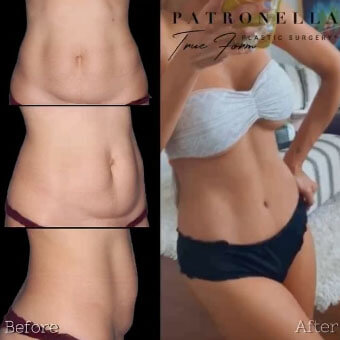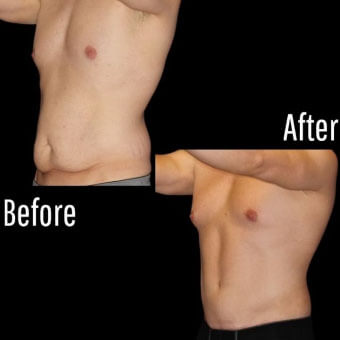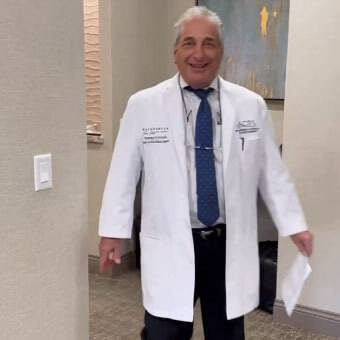The Tummy Tuck Incision: A Common Misconception & Why it Matters
Posted July 20, 2012 in Tummy Tuck
By Plastic Surgeon Chris Patronella, MD, FACS
One of the most common misconceptions I encounter concerning the tummy tuck and other cosmetic plastic surgery procedures is that major changes can be made through small incisions. Minor improvements can be achieved through small incisions but not major.
In my practice, more than 90 percent of my tummy tuck patients require a hip-to-hip incision to achieve the necessary improvements that my patients seek and that I seek. When this is the case, neither liposuction or a mini tummy tuck will deliver good results, though these procedures were recommended to many of the patients I see who desire tummy tuck revision surgery to correct the inadequate results they received. Abdominoplasty performed through a small incision has left them with an upper abdomen that bulges and a lower abdomen that is flat, the result of an incision that was too small to achieve the comprehensive level of correction that is typically required to tighten loose skin and muscles both above and below the belly button.
To a great degree, marketing leads people to believe that dramatic improvements can be accomplished with short and less invasive procedures. But often, only a small percentage of patients are true candidates for these types of procedures.
One of the hardest things to do is to disappoint a patient with a recommendation that is different from what they’d hoped to hear, but you can’t always follow their desires. It is the responsibility of a plastic surgeon to apply an artistic eye to a person’s body shape and then educate this individual as to what is necessary to create the right look.
What Will My Scars Look Like After My Tummy Tuck?
The remarkable results of your True Form Tummy Tuck® with Dr. Chris Patronella are made possible by the strategic placement of surgical incisions. Incisions are a part of any major surgery, and patients should expect that they will leave scarring. Still, your tummy tuck scars will be inconspicuously placed and will heal over time to a point that, for most patients, they are not a significant aesthetic concern. With Dr. Patronella’s Scar Therapy Program, you can minimize your surgical scars from abdominoplasty. In addition, Dr. Patronella offers non-surgical skin rejuvenation treatments that effectively diminish scars.
Scar Placement
Tummy tuck incisions must be placed in an area that will let the surgeon access and tighten the underlying tissues and muscles. For Dr. Patronella’s True Form Tummy Tuck®, the lower abdominal incision is placed low on the bikini line. Due to its location, patients are typically able to easily conceal this scar with clothing, including swimwear and underwear.
How Scarring Heals Over Time
Initially after the procedure, the incision site will appear as a thin, pink line. Over the next few weeks and months, it will develop a darker color and raised, rough tissue. Like a small cut can develop a scab before healing, this is a natural biological reaction as the skin increases blood supply and collagen production to heal the tissue. With proper care, the scar will gradually lighten, break down, and take on a flatter, less noticeable appearance. Over the next six months to two years, most scars will progressively fade and soften. The care you exert for your incision and in following Dr. Patronella’s Scar Therapy Program will play a significant role in the quality of your scar tissue.
Incision Care and Dr. Patronella’s Scar Therapy Program
To minimize scarring after tummy tuck surgery, carefully follow all of Dr. Patronella’s incision care instructions as well as his Scar Therapy Program. With all scar treatment products, watch for signs of irritation or an allergic reaction and contact our practice right away if you have any concerns. You will be given detailed instructions on caring for your incision to protect it from irritants and infection during the early weeks after surgery.
The Scar Therapy Program, which begins five to six weeks after your procedure, includes regular use of multiple skin products to treat the incision scar. The Tri-Retinol Complex™ by SkinMedica® should be applied nightly to clean skin to exfoliate the scar surface and reduce thickness and pigmentation. If your skin is intolerant of the retinol, you can use the Vitamin C+E Complex instead to exfoliate and condition the scar simultaneously. Next is the TNS Recovery Complex®, applied over the retinol at night and over a moisturizer in the morning to flatten the scar and seal in natural oils. Patients who have a greater tendency to develop hyperpigmentation (especially those with darker skin tones) may need Hydroquinone 4% to bleach and counteract this possibility. Finally, the Scar Recovery Gel with Centelline™ contains a patented blend of therapeutic ingredients that will diminish the appearance of the scar. The Scar Therapy Program is designed to be continued for six to 12 months and must be performed with consistency and patience to help guarantee the best aesthetic results.







